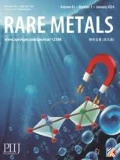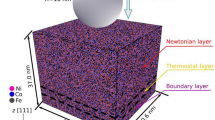Abstract
The nanomechanical behaviors of (110) and (111) CdZnTe crystals were investigated by nanoindentation. It was found that the indenter tip was adhered by the removed materials in scanning testing area although the scanning force on the tested surface was very small (1000 nN), which would affect the testing result of nanoindentation, so the indenter was clean before nanoindentation test. The experimemtal results showed that the hardness and Young’s modulus decreased with the increase of indentation loads on the same plane. Because of the anisotropy of the CdZnTe crystal, the average hardness of (110) plane is 35% lower than that of (111) plane, and there are about 30% difference of the hardness along different crystallographic directions on the same plane. The hardness in 0° and 120° testing directions was the same due to the threefold symmetry of a Berkovich indenter. And the anisotropy affected the surface quality during machining of CdZnTe crystal.
Similar content being viewed by others
References
Duff M.C., Hunter D.B., Burger A., Groza M., Buliga V., and Black D.R., Effect of surface preparation technique on the radiation detector performance of CdZnTe, Appl. Surf. Sci., 2008, 254(9): 2889.
Wang X.Q., Jie W.Q., Li Q., and Gu Z., Surface passivation of CdZnTe wafers, Mater. Sci. Semicond. Process., 2005, 8(6): 615.
Badano G., Garland J.W., and Sivananthan S., Accuracy of the in situ determination of the CdZnTe temperature by ellipsometry before the growth of HgCdTe by MBE, J. Cryst. Growth, 2003, 251(1): 571.
Wang T., Jie W.Q., Zhang J.J., Yang G., Zeng D.M., Xu Y.D., Ma S.Y., Hua H., and He K., Study on the behaviors of impurities in cadmium zinc telluride, J. Cryst. Growth, 2007, 304(2): 313.
Marchenko M.P., Golyshev V.D., and Bykova S.V., Investigation of Cd1−x ZnxTe composition inhomogeneity at crystal growth by AHP-method, J. Cryst. Growth, 2007, 303(1): 193.
Zeng D.M., Jie W.Q., Wang T., Zha G.Q., and Zhang J.J., Effects of mosaic structure on the physical properties of CdZnTe crystals, Nucl. Instrum. Methods A, 2008, 586(3): 439.
Kumar S., Kapoor A.K., Nagpal A., Sharma S., Verma D., Kumar A., Raman R., and Basu P.K., Effect of substrate dislocations on the Hg in-diffusion in CdZnTe substrates used for HgCdTe epilayer growth, J. Cryst. Growth, 2006, 297(2): 311.
Schlesinger T.E., Toney J.E., Yoon H., Lee E.Y., Brunett B.A., Franks L., and Hames R.B., Cadmium zinc telluride and its use as a nuclear radiation detector material, Mater. Sci. Eng. R, 2001, 32(4–5): 103.
Berke P., Tam E., Delplancke-Ogletree M.P., and Massart T.J., Study of the rate-dependent behavior of pure nickel in conical nanoindentation through numerical simulation coupled to experiments, Mech. Mater., 2009, 41(2): 154.
Jang B. and Matsubara H., Hardness and Young’s modulus of nanoporous EB-PVD YSZ coatings by nanoindentation, J. Alloys Compd., 2005, 402(1–2): 237.
Viswanath B., Raghavan R., Gurao N.P., Ramamurty U., and Ravishankar N., Mechanical properties of tricalcium phosphate single crystals grown by molten salt synthesis, Acta Biomater., 2008, 4(5): 1448.
Stus N.V., Dub S.N., Stratiychuk D.A., and Lisnyak V.V., Pop-in effect at nanoindentation of lithium tetraborate (100) face, J. Alloys Compd., 2005, 403(1–2): 305.
Oliver W.C. and Pharr G.M., An improved technique for determining hardness and elastic modulus sensing load and displacement sensing indentation experiments, J. Mater. Res., 1992, 7(6): 1564.
Gao H., Huang Y., Nix W.D., and Hutchinson J.W., Mechanism-based strain gradient plasticity—I. Theory, J. Mech. Phys. Solids, 1999, 47(6): 1239.
Nix W.D. and Gao H.J., Indentation size effects in crystalline materials: a law for strain gradient plasticity, J. Mech. Phys. Solids, 1998, 46(3): 411.
Javis M.R., Perez R., Bouwelen F.M., and Payne M.C., Microscopic mechanism for mechanical polishing of diamond (110) surfaces, Phys. Rev. Lett., 1998, 80(16): 3428.
Author information
Authors and Affiliations
Corresponding author
Rights and permissions
About this article
Cite this article
Li, Y., Kang, R., Gao, H. et al. Nanomechanical behaviors of (110) and (111) CdZnTe crystals investigated by nanoindentation. Rare Metals 28, 570–575 (2009). https://doi.org/10.1007/s12598-009-0110-7
Received:
Revised:
Accepted:
Published:
Issue Date:
DOI: https://doi.org/10.1007/s12598-009-0110-7




